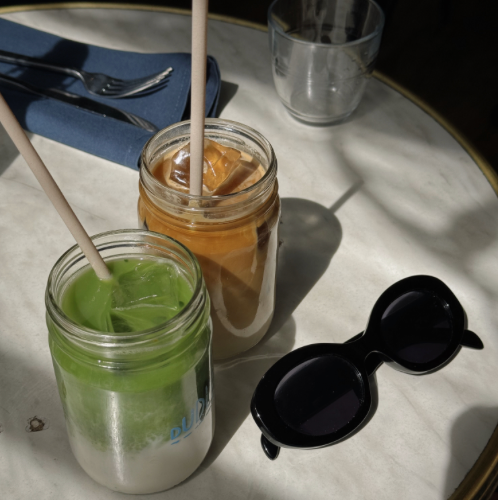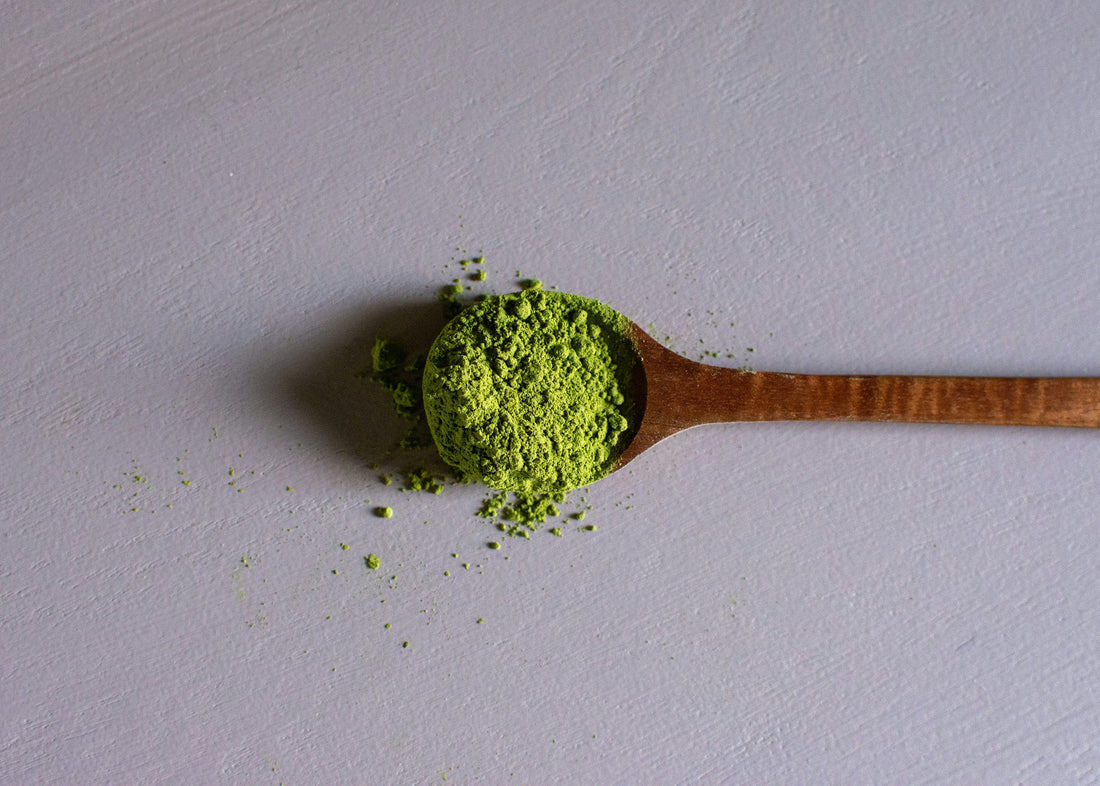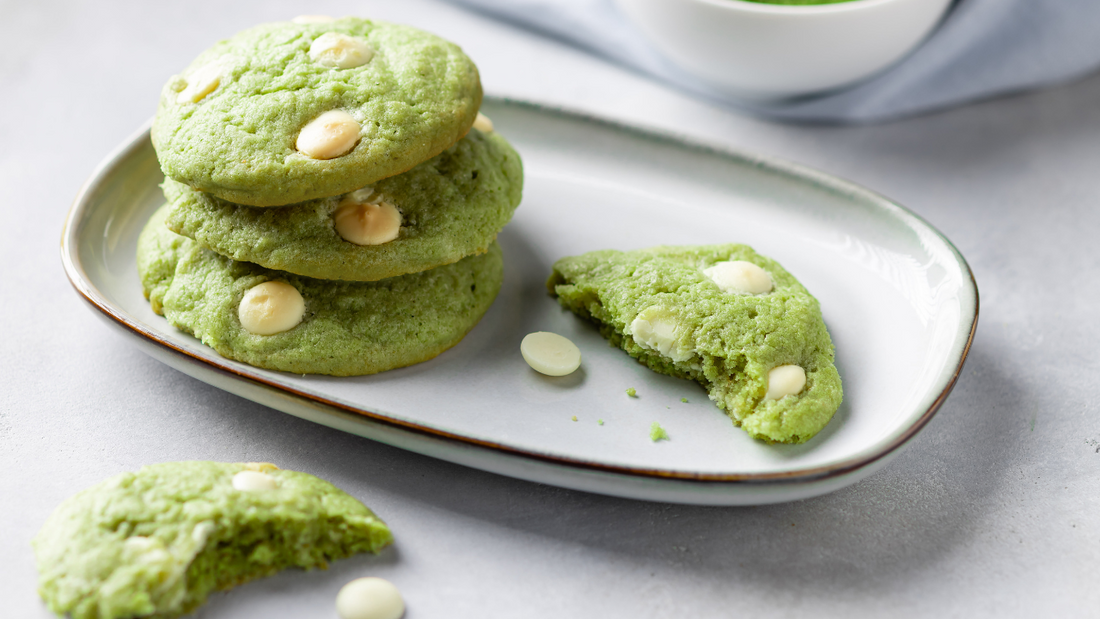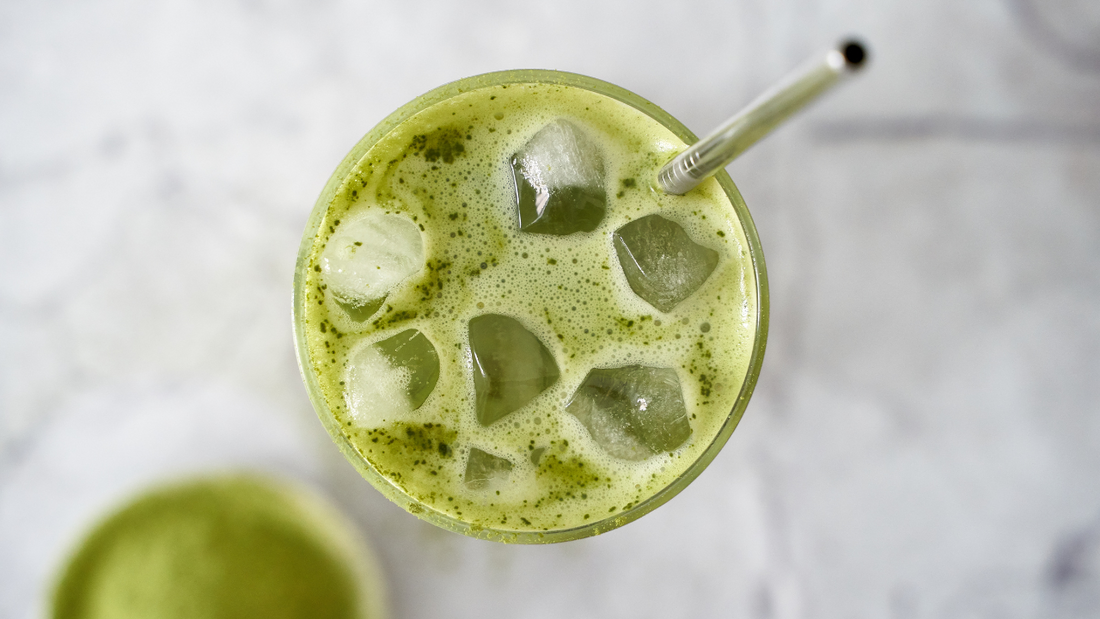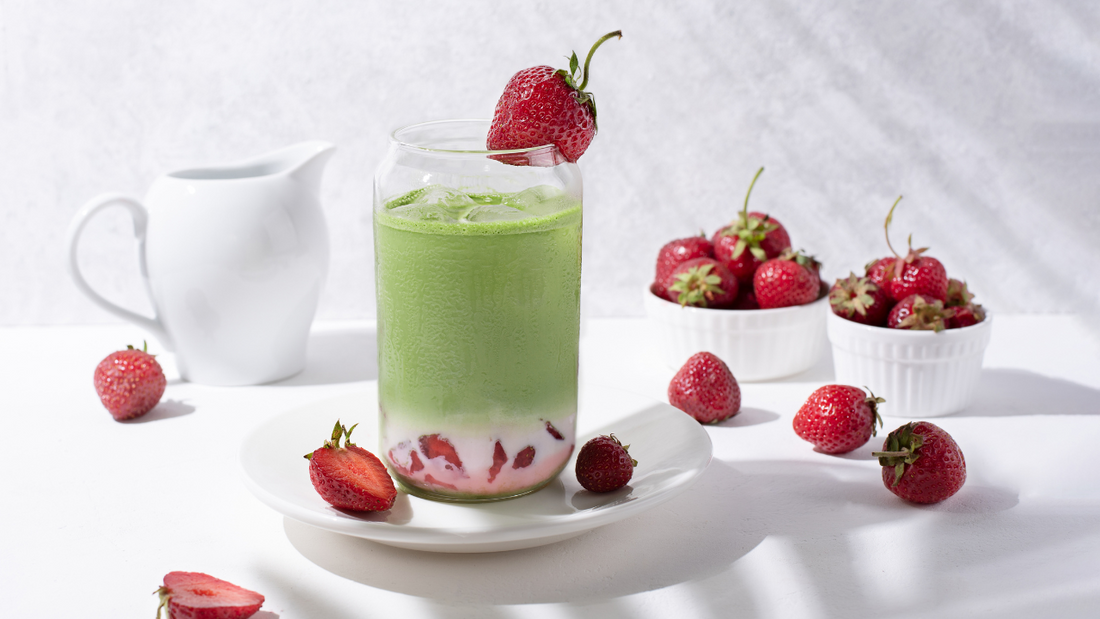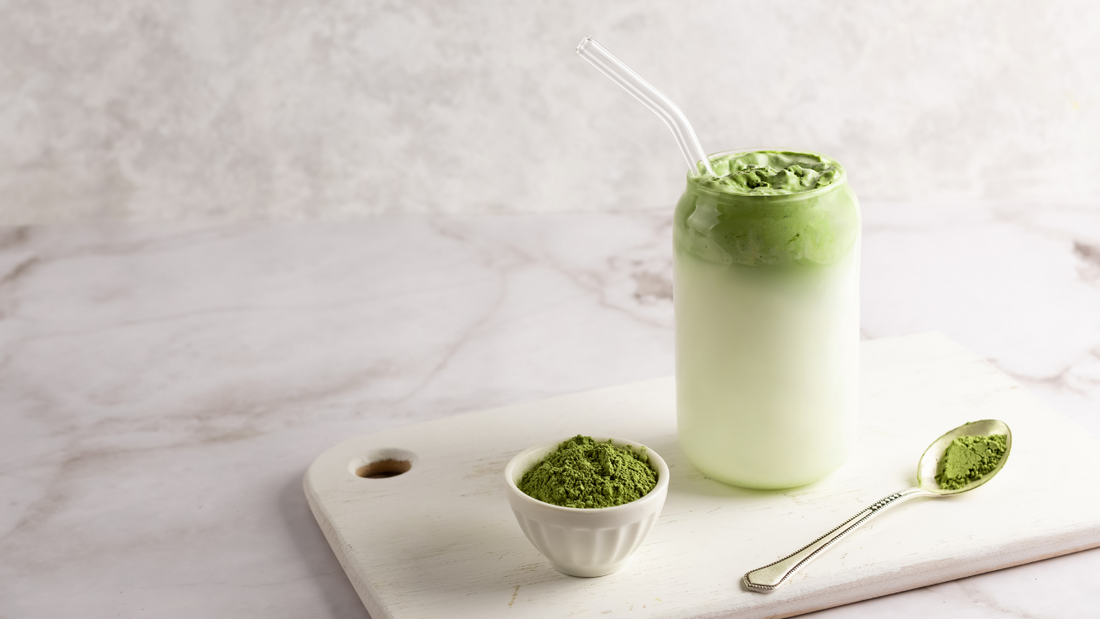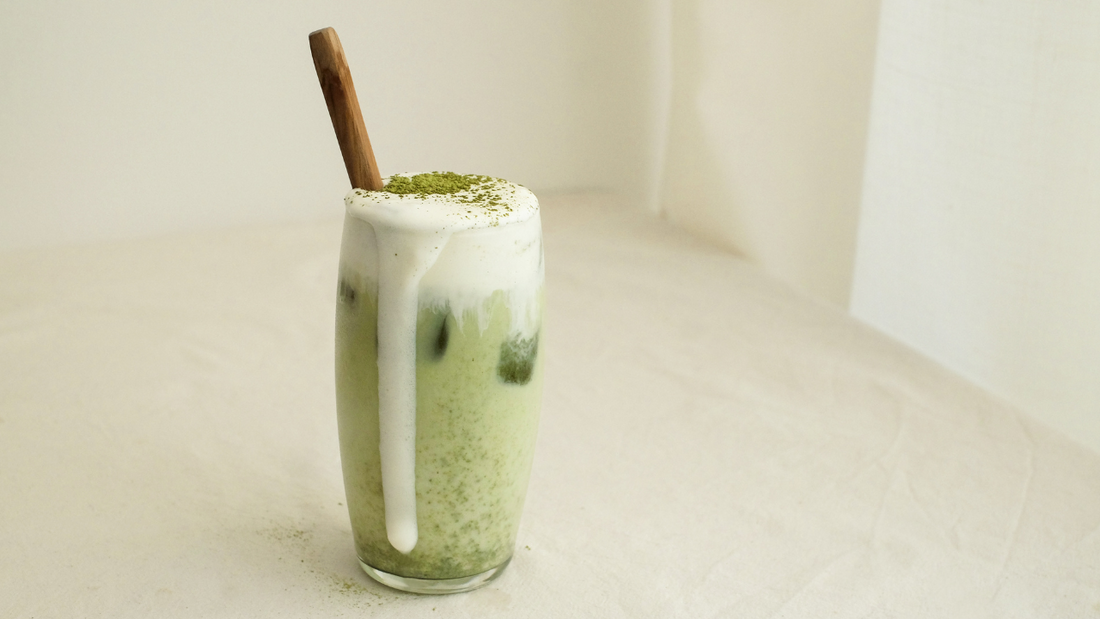Exciting articles about our matcha 🫶
Matcha vs Maté: What's the difference?
Matcha vs Mate: What’s the Difference? The world of natural energy drinks is full of treasures, and among them, matcha and mate are becoming increasingly popular. Although these two drinks are often confused, they have very different origins, compositions, and effects. Let’s explore what sets them apart. Origins and Culture Matcha is a powdered Japanese green tea made from tea leaves (Camellia sinensis) grown in the shade before harvest. This special technique enhances the concentration of nutrients and chlorophyll, giving matcha its vibrant green color. The preparation of matcha is also rooted in the Japanese tea ceremony, a millennia-old tradition. Mate, on the other hand, is a traditional South American infusion made from the leaves of the yerba mate tree (Ilex paraguariensis). Originating in regions like Argentina, Paraguay, and Brazil, it is often consumed in a gourd with a metal straw called a bombilla. Mate is deeply connected to the indigenous cultures of South America. Composition and Taste Matcha stands out for its high content of catechins, powerful antioxidants, and L-theanine, an amino acid known for its relaxing properties. Because it is consumed whole (since the leaf is ground), it is more concentrated in nutrients than regular tea. Its taste is smooth, vegetal, with a slight bitterness. Mate contains caffeine but also theobromine, a stimulating compound also found in chocolate. Mate is known to provide sustained energy without the anxiety spikes or “crashes” that caffeine can cause. Its taste is more bitter, earthy, with sometimes smoky notes depending on the preparation method. Effects on the Body Matcha provides stable energy thanks to the combination of caffeine and L-theanine, promoting concentration and relaxation at the same time. It is often favored for meditation or activities that require prolonged focus. Mate acts more like a classic stimulant, with a quick energy boost. It is appreciated by those looking for an immediate pick-me-up, but less abrupt than coffee, thanks to the presence of theobromine, which smooths out the effects of caffeine. Conclusion Matcha and mate are two fascinating drinks, rich in culture and benefits. If you are looking for calmer, more centered energy, matcha could be your ally. If you prefer a natural stimulant with a more direct energizing effect, mate will meet your expectations. Everyone has their preference, but both offer a great alternative to traditional coffee.
Learn moreRecipe for Matcha Tea and White Chocolate Cookies
Matcha and White Chocolate Cookies Discover a reimagined version of our matcha tea and white chocolate cookie recipe, created by Laurie. These indulgent cookies are easy to make and delightful to enjoy. Ingredients for 10 cookies: 85 g brown sugar 85 g soft butter 1 pinch of Camargue salt 180 g flour 1 teaspoon baking powder 1 packet of vanilla sugar 5 g Premium matcha 1 egg A few white chocolate chips Preparation: Mix the Dry and Wet Ingredients: In a bowl, mix the brown sugar, butter, and pinch of Camargue salt. Add the Other Ingredients: Incorporate the egg, vanilla sugar, flour, baking powder, matcha, and white chocolate chips. Shape the Dough Balls: Form balls of dough and place them on parchment paper, spacing them out. Bake in the Oven: Bake for 10 to 12 minutes at 180°C (350°F). Enjoy these matcha tea and white chocolate cookies, perfect for a delicious snack break!
Learn moreHow to Lose Weight with Matcha Tea?
The matcha tea, often praised for its fat-burning properties, can be an effective ally for weight loss. Let's explore the slimming properties of matcha, its beneficial effects on metabolism and fat elimination, as well as tips for optimal consumption. The Matcha Tea: A Weight Loss Ally Scientific research has shown the role of matcha tea in fat oxidation and weight loss thanks to its specific nutrients. Rich in Antioxidants and Amino Acids The matcha tea leaves contain a high concentration of catechins, powerful antioxidants that stimulate thermogenesis, promoting fat burning. One study showed that daily consumption of 372 mg of catechins, including 270 mg of EGCG, led to significant weight loss and reduced waist circumference. Additionally, antioxidants fight free radicals, protecting organs and promoting overall health. Matcha is also rich in amino acids like L-theanine, which boosts metabolism and facilitates fat burning while reducing stress, a factor in weight gain. L-theanine promotes relaxation and combats anxiety, contributing to better hormonal balance. Matcha's Caffeine for Weight Loss The caffeine, or theine, present in matcha also stimulates metabolism and helps burn fat more quickly. With about 45 mg of caffeine per cup, matcha increases the availability of fatty acids in the body, making it easier to burn them during physical exercise. Matcha's Diuretic Properties Matcha tea has diuretic properties, helping to eliminate toxins and excess fluids, which can reduce water retention. Additionally, matcha is rich in fiber, increasing feelings of fullness without adding extra calories. Does Matcha Tea Make You Lose Weight? Yes, matcha promotes weight loss, but it should be combined with a healthy lifestyle and a calorie deficit. Here are some tips to maximize its effects. How to Drink Matcha Tea for Weight Loss It is recommended to drink between 2 and 5 cups of tea per day, but for matcha, an average of 3 cups is ideal. One teaspoon of matcha per cup is sufficient. Avoid excessive consumption to prevent caffeine-related side effects. What is the Best Matcha for Weight Loss? Opt for organic, high-quality matcha with a vibrant green color, fine texture, and a flavorful taste without bitterness. Ceremonial-grade matcha is the richest in nutrients, but premium and classic matcha are also of good quality. A Healthy Diet and Physical Activity Balanced Diet For effective weight loss, combine matcha with a balanced, nutrient-rich diet and avoid processed foods and overeating. Regular Physical Exercise Regular physical activity is essential for burning calories and maintaining a healthy weight. Strength training can help burn fat while preserving muscle mass. Avoid drastic diets and focus on balance and consistency in your habits. Conclusion Matcha tea can be an excellent complement for weight loss when integrated into a healthy and balanced lifestyle. Drink it in moderation, combine it with a nutritious diet, and practice regular physical activity for the best results. FAQs How should I drink matcha tea to promote weight loss? It is recommended to drink matcha tea in the morning to enjoy its stimulating effects. Combine it with a healthy diet and regular physical activity for optimal results. Should I exercise after drinking matcha tea? Yes, exercising after drinking matcha tea can increase fat burning. Wait about 30 minutes after drinking the tea before starting your physical activity. What are the health benefits of regularly consuming matcha tea for weight loss? Matcha tea is rich in antioxidants, especially catechins, which stimulate metabolism and increase fat burning. It also promotes good cardiovascular health and helps reduce visceral fat.
Learn moreThe 12 Benefits of Matcha Tea
Matcha tea is a natural beverage prized not only for its unique taste but also for its many health benefits. Considered a "superfood," matcha is rich in nutrients and antioxidants due to its specific cultivation and consumption method. Here is a detailed presentation of the benefits of matcha for your health and well-being. 1. A Source of Sustained Energy Matcha contains caffeine (also called theine) as well as L-theanine, an amino acid with calming effects. This combination provides a gentle and sustained energy boost, without the peaks of excitement followed by sudden drops often associated with coffee. 2. Stress Reduction L-theanine promotes the production of serotonin and dopamine, the pleasure and happiness hormones, as well as GABA, a neurotransmitter with anti-stress effects. Drinking matcha daily can help reduce stress and promote a more relaxed feeling. 3. Improved Concentration Matcha stimulates cognitive functions and creativity thanks to L-theanine. It is an ideal drink before an exam, intense intellectual work, or a meditation session to stay both calm and focused. 4. Skin and Hair Beauty Rich in antioxidants and vitamins, matcha helps protect cells from oxidation, promoting beautiful skin and healing. The antioxidants in matcha are also excellent for hair growth and strengthening hair fibers. 5. Strengthening the Immune System Thanks to its powerful antioxidants and vitamins (C, E, A), matcha boosts the immune system, helping the body defend against diseases and infections. 6. Enhanced Athletic Performance Matcha improves endurance and aids recovery thanks to its antioxidants that promote good muscle oxygenation and limit lactic acid production, which causes muscle soreness. 7. Aids in Weight Loss Matcha promotes fat burning thanks to its caffeine and catechins (EGCG). It also has an appetite-suppressing effect by stimulating the production of satiety hormones. 8. Natural Detoxification Rich in chlorophyll, matcha helps eliminate toxins and heavy metals from the body, thereby improving overall health and the ability of organs to function properly. 9. Good for the Gut Microbiome Matcha improves digestion thanks to its antioxidants that strengthen intestinal immunity and promote the production of good bacteria, thus preventing inflammation and intestinal discomfort. 10. Oral Health Matcha prevents the development of bacteria, cavities, and plaque buildup thanks to the vitamin F (fluoride) it contains, promoting good oral health. 11. Heart Health The catechins in matcha are beneficial for heart health, helping to protect the walls of blood vessels, promoting good circulation, and regulating blood pressure. 12. Disease Prevention Thanks to its numerous benefits, matcha helps prevent certain diseases such as cardiovascular disease, cholesterol, arthritis, and inflammation, providing overall protection for health. Conclusion In addition to its unique flavor, matcha tea offers many health benefits due to its nutritional qualities. To fully enjoy these benefits, choose a high-quality organic matcha and consume it regularly as part of a healthy, balanced lifestyle. Limit your consumption to 2-3 cups per day to reap its benefits without excess. FAQs What are the health benefits of matcha tea?Matcha tea is rich in antioxidants, vitamins, and minerals. It promotes concentration, aids in weight loss, strengthens the immune system, reduces the risk of heart disease, and more. Can matcha tea help with weight loss?Yes, matcha tea can help with weight loss. It is rich in catechins, a type of antioxidant that aids in weight loss by speeding up metabolism and increasing fat burning. How can I enjoy the benefits of matcha?Choose high-quality organic matcha, store it properly, and prepare it with water at the right temperature to preserve its nutrients. Consume it regularly as part of a healthy lifestyle. How much matcha should I drink per day?Limit yourself to 2-3 cups per day to enjoy the benefits of matcha without excess.
Learn moreWhat is Ceremonial Matcha?
Ceremonial matcha is an exceptional quality green tea powder used in the traditional tea ceremony in Asia. This type of matcha stands out for its smooth umami flavor, vibrant green color, and ultra-fine texture, achieved through a meticulous cultivation and production process. Difference Between Ceremonial Matcha and Ceremony Matcha The terms "ceremonial matcha" and "ceremony matcha" refer to the same quality of tea, intended for the tea ceremony. The use of one term or the other often depends on the supplier’s or brand’s preference. Difference Between Ceremonial Matcha and Culinary Matcha Culinary matcha is made from more mature leaves and has a stronger, more bitter flavor, ideal for cooking and baking. On the other hand, ceremonial matcha is designed to be enjoyed pure, with a smooth flavor and velvety texture. The Different Grades of Matcha Ceremonial Matcha: The highest grade, ideal for the tea ceremony. Premium Matcha: A slightly lower grade, suitable for regular consumption. Culinary Matcha: Mainly used for cooking and baking. Origins and Characteristics of Ceremonial Matcha Ceremonial matcha comes from the youngest and most tender tea leaves, shaded before harvest to increase chlorophyll and nutrients. After harvest, the leaves are steamed, dried, and finely ground into an ultra-fine powder. Health Benefits of Ceremonial Matcha Antioxidants: Rich in catechins, including EGCG, which helps fight free radicals. Sustained Energy: The combination of caffeine and L-theanine provides smooth, long-lasting energy. Detoxification: Chlorophyll helps eliminate toxins and heavy metals. Improved Focus: L-theanine promotes relaxation and mental clarity. Immune Support: Boosts the immune system with its vitamins and antioxidants. How to Prepare Ceremonial Matcha: Ingredients: 1 to 2 grams of ceremonial matcha powder (about one teaspoon) 50 to 70 ml of hot water (75°C) Accessories: A chasen (bamboo whisk) A tea bowl, cup, or glass Steps: Place the matcha powder in the bowl. Add the hot water. Whisk vigorously with the chasen in an “M” motion until a fine, even foam forms. Add water or milk (about 100 ml) if desired. Why Choose Soyo Matcha Ceremonial Matcha? At Soyo Matcha, we are committed to offering the highest quality matcha, respectful of traditions and carefully cultivated. We support local farmers and ensure full traceability of our products. Soyo Matcha ceremonial matcha offers more than just a drink. It’s a sensory experience, an ancient tradition, and an invaluable source of health benefits. Whether you are a passionate enthusiast or simply curious, let yourself be charmed by this unique experience. So, ready to taste?
Learn moreMatcha Latte: The Quick and Easy Recipe
Matcha Latte: The Simple and Quick Recipe Matcha latte is a delicious drink that replaces traditional water with milk, offering a comforting and delightful experience. Here's our favorite recipe for preparing a simple matcha latte every day. Matcha Latte Recipe Ingredients: 1 teaspoon of quality matcha (Ceremonial, Premium, or Classic). Your choice of milk (oat, coconut, soy, rice, hazelnut...). Preparation without a bamboo whisk: Use a mixer, blender, shaker, or milk frother. Heat the milk without burning it (keep it under 80°C). Add the hot milk to the matcha. Blend everything together. You can add a sweetener if desired (honey, maple syrup, agave syrup...). Preparation with a bamboo whisk: Place 1 teaspoon of matcha in a bowl. Pour about 70 ml of hot water (70-80°C) and whisk vigorously in an M shape with a chasen. Pour your preparation into a mug and add the hot milk. Add a sweetener if needed. Cold Matcha Latte The matcha latte can also be enjoyed cold. Add cold milk and ice cubes for a refreshing version. You can also use syrups or spices to customize your drink. Which Matcha to Choose? Our three types of matcha are suitable for a latte: Ceremonial Matcha: No bitterness, voted best organic product of 2022. Premium Matcha: Smooth and flavorful. Classic Matcha: For those who prefer a slight bitterness. How to Dose Matcha Tea? We recommend 1g to 1.5g of matcha per 250 ml cup. Adjust according to your taste and the type of matcha used. Use a teaspoon to measure or a special chashaku spoon if you have one. Which Milk for a Creamy Matcha Latte? Opt for creamy milk like cow's milk, soy, oat, almond, or coconut milk for a nice foam. Rice and spelt milks are less creamy. Conclusion The matcha latte is a delicious and health-beneficial drink, perfect for breakfast, afternoon tea, or a break. Enjoy its benefits by incorporating it into your daily routine. FAQs How to prepare a Matcha Latte?Whisk matcha powder with some hot water until smooth. Then add the milk of your choice, hot or cold. What are the benefits of Matcha Latte?Matcha Latte combines the benefits of matcha (energy, concentration, calming) with those of milk (proteins, calcium).
Learn moreHow to Prepare Matcha Tea?
Since the 2000s, matcha tea, a 100% natural tea rich in antioxidants with a unique taste, has crossed the borders of Japan. It is now prepared without a whisk, consumed with milk or plant-based beverages, and used as an ingredient in various pastry recipes. In the West, it is most popular as a matcha latte! This article explains how to prepare a matcha latte and a traditional matcha. Unlike other teas, matcha doesn't steep because it's a powdered tea that is ingested directly. Don't worry, preparing this drink is easier than it seems! Ingredients for preparing a matcha latte or traditional matcha 1 level teaspoon of organic matcha powder (Ceremony, Premium, or Classic). You can use a regular spoon or a bamboo spoon ("chashaku"). Your choice of milk (oat milk, coconut milk, rice milk, or any other plant-based milk). A sweetener (honey, sugar, agave syrup), although our matchas are extremely smooth and may not need any sweetening. A chasen (traditional bamboo matcha whisk) or an electric frother. A bowl (chawan in Japanese) or a cup/glass/mug. Preparation of the matcha latte or traditional matcha Prepare the matcha with water: Place one teaspoon of matcha powder in a bowl. Add 70 ml of water heated to around 75°C (not boiling water to avoid bitterness). Be sure to tightly close the matcha container for optimal storage. Whisk the matcha: Use a chasen to whisk vigorously in M-shaped movements (not 8-shaped) to avoid clumps. The whisk should barely touch the bowl. Add the milk: For a hot matcha latte, add your choice of milk. You may also add a sweetener if desired. Matcha Usucha and Koicha Usucha (薄茶): Prepared with about 2g of matcha powder and 75 ml of water to create a thin and balanced texture. Koicha (濃茶): Prepared with a larger amount of matcha and less water, resulting in a thicker texture and more intense flavor. Use higher-quality matchas for this preparation. Iced matcha Matcha can also be enjoyed cold. Use warm water to dissolve the matcha powder, then add cold milk and ice cubes for an iced matcha latte. You can customize your drink with syrups, cinnamon, or other ingredients according to your taste. Tips and Variations If you don't have a whisk or frother, a blender, shaker, or hand mixer can be used to mix the matcha. Matcha can also be added to smoothies, yogurts, or various pastry recipes like madeleines, cakes, and cookies. Enjoy the preparation of your matcha and savor each sip of this drink with numerous benefits!
Learn more

